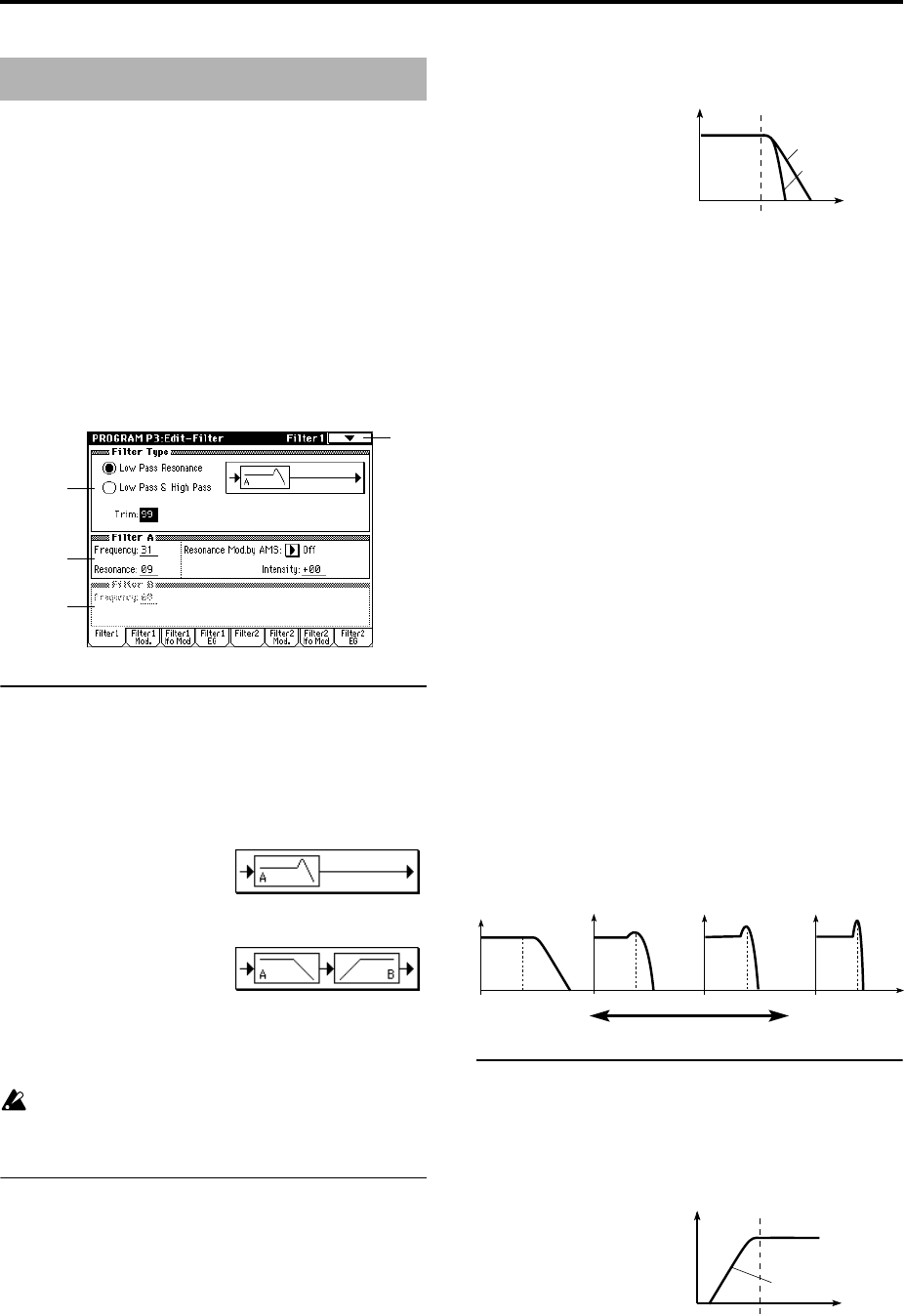
16
Here you can make settings for the filters that will be used by
oscillators 1 and 2. You can select either a 24 dB/octave low
pass filter with resonance, or a series connection of a 12 dB/
octave low pass filter and a 12 dB/octave high pass filter.
When “Oscillator Mode” (1–1a) is set to Single, filter 1 will
be used, and when it is set to Double, filters 1 and 2 will be
used.
When Single is selected, pages relating to filter 2 cannot be
selected.
3–1: Filter1
Here you can specify the basic filter type used by oscillator
1, and set the cutoff frequency and resonance.
3–1a: Filter Type
Filter Type
[Low Pass Resonance, Low Pass & High Pass]
Selects the type for filter 1.
Low Pass Resonance: 24 dB/octave low pass filter with res-
onance.
Low Pass & High Pass: 12 dB/octave low pass filter and 12
dB/octave high pass filter in series.
Trim [00…99]
Adjusts the level at which the audio signal output from
oscillator 1 is input to filter 1A.
If the trim value is set too high, the sound may be dis-
torted if Resonance is set to a high value or when you
play a chord.
3–1b: Filter A
This is a filter that cuts the high-frequency region above the
cutoff frequency.
This is the most common type of filter, and is used to cut
part of the overtone components, making an originally
bright timbre sound more mellow (darker).
When the “Filter Type” is Low Pass Resonance, the cutoff
will have a steeper slope.
Frequency (A Frequency) [00…99]
Specifies the cutoff frequency of filter 1A.
Resonance (A Resonance) [00…99]
This emphasizes the overtone components that lie in the
region of the cutoff frequency specified by “Frequency (A
Frequency),” producing a more distinctive sound. Increas-
ing this value will produce a stronger effect.
Resonance Mod. by AMS
[Off, (PEG, FEG, AEG, LFO, KT, EXT)]
Selects the source that will control the “Resonance (A Reso-
nance)” level (“AMS List” ☞p.242).
Intensity (AMS Intensity) [–99…+99]
Specifies the depth and direction of the effect that “Reso-
nance Mod. by AMS” will have on the resonance level speci-
fied by “Resonance (A Resonance).”
For example if Velocity has been selected, changes in key-
board velocity will affect the resonance.
With positive (+) values, the resonance will increase as you
play more strongly, and as you play more softly the reso-
nance will approach the level specified by the “Resonance
(A Resonance)” setting.
With negative (–) values, the resonance will decrease as you
play more strongly, and as you play more softly the reso-
nance will approach the level specified by the “Resonance
(A Resonance)” setting.
The resonance level is determined by adding the “Reso-
nance (A Resonance)” and “Intensity (AMS Intensity)” val-
ues.
3–1c: Filter B
This parameter will be displayed when “Filter Type” (3–1a)
is set to Low Pass & High Pass.
This filter cuts the low-frequency range that lies below the
cutoff frequency. By cutting the lower overtones, it lightens
the tone.
Frequency (B Frequency) [00…99]
Specifies the cutoff frequency of filter 1B.
Program P3: Edit–Filter
3–1
3–1a
3–1b
3–1c
Frequency
Level
Low Pass
12dB/oct
24dB/oct
The effect of resonance
Low Pass
Level
Low resonance value High resonance value
Level
Frequency
High Pass
12dB/oct


















